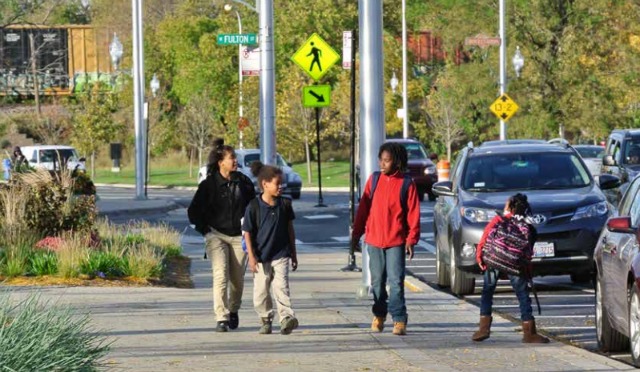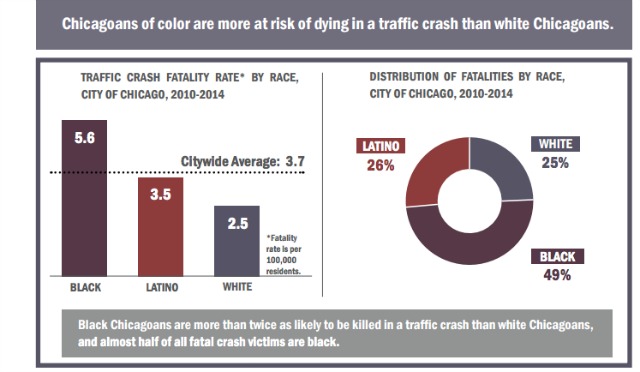Deadly Crashes Disproportionately Hit Black Chicagoans & South, West Side Residents. Here's Chicago's Plan To Fix It.
By Stephen Gossett in News on Jun 12, 2017 9:09PM

Vision Zero Chicago
The City of Chicago has finally released its Vision Zero initiative, the city's months-in-the-making plan to eliminate traffic fatalities and serious injuries within nine years. There were a few alarming data points that jumped out immediately, namely the high degree with which people from poor communities are killed in traffic crashes, and the staggering, increased risk for traffic death faced by people of color in Chicago.
People from communities considered to have a high economic hardship, as defined by the Chicago Department of Public Health parameters, die more often in traffic incidents than those from medium or low hardship levels. People from those poorest communities also die at a higher rate in traffic crashes than people from lower hardship levels. A staggering 47 percent of traffic fatalities between 2010 and 2014 occurred in high-hardship areas.
At the same time people of color in Chicago are more likely to die in a traffic crash than white residents. Nearly half of the people killed in such a manner between 2010 and 2014 were black.

Vision Zero Chicago

Vision Zero Chicago
The data examined in the action plan—which was put together with the input of a dozen agencies and departments (CDOT, CPD, CTA and many others)—also pinpointed eight High Crash Areas where "communities experience significantly higher rates of crashes that cause death and serious injury than Chicago's average." One area is downtown, which is obviously heavily trafficked and saw the most number of crashes. But the other seven fall on the South and West Sides, in High Economic Hardship communities:
- Belmont-Cragin
- Near West Side
- Austin
- Near Northwest Side (Humboldt Park and West Town)
- West Side (East Garfield Park, West Garfield Park, North Lawndale)
- Englewood
- Washington Park and Grand Boulevard
In addition to a Downtown Task Force, Vision Zero calls for public and private stakeholders in those affected neighborhoods "to set goals and metrics inclusive of community concerns." Actions include targeted education and awareness to improve dangerous driving and police involvement "driven by community input and support." That input will no doubt be key, especially considering disproportionate patterns that have come to light in terms of ticketing. The goal is to reduce severe crashes in High Crash Areas by 40 percent by 2020.
“Chicago has made progress in making our streets safer, but we still experience far too many traffic crashes,” Emanuel said in a statement. “The status quo is unacceptable,” Mayor Emanuel said. “We will streamline our efforts to protect the lives, health and well-being of all Chicagoans.”
To help tackle some of these dangerous inequities, the city will launch a pilot project this summer on Garfield Park and Austin with a $185,000 grant from the National Safety Council. But overall the plan looks a bit light on similar specifics and funding mechanisms. The goals are laudable, so lets hope they get the money they'll need.
“The three-year plan shows the city is serious about preventing crashes and making our streets safer for everyone, especially the most vulnerable people who are walking and biking,” said ATA Executive Director Ron Burke. “Now we need to make sure our elected officials at every level of government provide appropriate funding support for the city to meet its ambitious goals.”